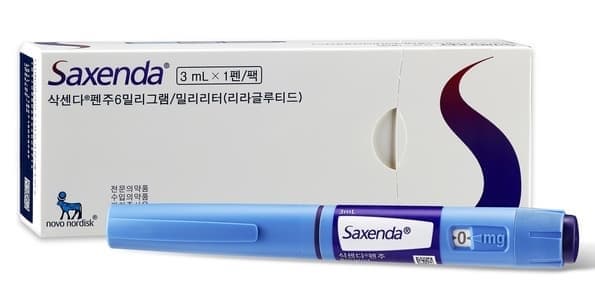
Important Safety Information for Saxenda® (liraglutide) Injection [Korean Edition]
Warning: Risk of Thyroid C-Cell Tumors
In animal studies, Saxenda caused thyroid tumors, including thyroid cancer. It is not known whether Saxenda will cause thyroid tumors or a type of thyroid cancer called medullary thyroid carcinoma (MTC) in humans. Inform your healthcare provider if you experience symptoms such as a lump or swelling in the neck, hoarseness, difficulty swallowing, or shortness of breath. These may be signs of thyroid cancer.
Do not use Saxenda if you or your family have ever had MTC or if you have an endocrine system condition known as Multiple Endocrine Neoplasia syndrome type 2 (MEN 2).
What is the FDA-Approved Use of Saxenda?
Saxenda is used as an adjunct to a reduced-calorie diet and increased physical activity for chronic weight management in adults with obesity or in adults with overweight plus a weight-related condition such as type 2 diabetes, high blood pressure, or high cholesterol.
Limitations of Use:
- Saxenda is not indicated for the treatment of type 2 diabetes or as part of a weight-loss regimen combined with other GLP-1 receptor agonists.
- It has not been studied in combination with other weight-loss medications or in individuals with a BMI less than 27 kg/m².
Who Should Not Use Saxenda?
Do not use Saxenda if:
- You or your family have a history of MTC or MEN 2.
- You have had a serious allergic reaction to liraglutide or any of its ingredients.
How Should I Take Saxenda?
- Saxenda is available as a pre-filled pen for subcutaneous injection.
- Inject Saxenda once daily at any time, with or without food, in the abdomen, thigh, or upper arm.
- Follow your provider’s instructions regarding dose increases, typically weekly, to reach the maintenance dose.
- Do not share pens or needles to prevent infections.
What Should I Tell My Provider Before Using Saxenda?
Inform your healthcare provider about your medical history, including:
- Thyroid cancer or endocrine system conditions
- Type 1 or type 2 diabetes
- Kidney disease
- Gallbladder disease
- Pancreatitis
- Gastrointestinal disorders
- Depression or suicidal thoughts
- Pregnancy, planning pregnancy, or breastfeeding
If you are pregnant or planning to become pregnant:
- Saxenda should not be used during pregnancy, as weight loss offers no benefit and may harm an unborn baby.
If you are breastfeeding:
- It is unknown if Saxenda passes into breast milk. Consult your provider to weigh the risks and benefits.
What Are the Most Serious Side Effects?
If you experience a medical emergency, call 911 or seek immediate medical help.
Serious side effects may include:
- Thyroid C-Cell Tumors: Inform your provider if you notice a neck lump, hoarseness, difficulty swallowing, or shortness of breath.
- Acute Pancreatitis: Seek medical attention for severe stomach pain that radiates to your back, with or without vomiting.
- Gallbladder Disease: Report symptoms such as severe stomach pain, jaundice, fever, or pale stools.
- Kidney Problems: Dehydration caused by nausea or vomiting can worsen kidney issues. Drink plenty of water.
- Suicidal Thoughts or Behavior: Monitor for changes in mood or mental health. Notify your provider if you have worsening symptoms.
- Severe Allergic Reactions: Stop using Saxenda if you experience swelling of the face or throat, severe rash, or difficulty breathing.
What Are the Most Common Side Effects of Saxenda?
- Nausea
- Diarrhea
- Constipation
- Vomiting
- Stomach pain
- Headache
- Low blood sugar (hypoglycemia)
- Tiredness
- Dizziness
- Injection site reactions
Pregnancy Registry:
A registry monitors pregnancy outcomes in women exposed to Saxenda during pregnancy. Pregnant patients or healthcare providers can contact Novo Nordisk at [local contact number].
For comprehensive information, consult the full Prescribing Information. Negative side effects can be reported to the Korean Ministry of Food and Drug Safety.
This document provides critical safety information but is not exhaustive. Always follow your provider’s guidance.
